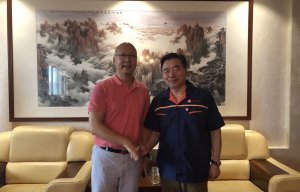
Largest-ever order for Oerlikon Neumag
Meltblown, spunbond, airlaid and coform routes to production highlighted in Geneva.

6th September 2021
Innovation in Textiles
|
Geneva, Switzerland
Oerlikon’s wide range of nonwoven technologies will be showcased at the INDEX 2020 exhibition in Geneva, Switzerland, from October 19-22.
Unique and highly-sophisticated nonwovens for filtration, insulation and sorption applications can be simply and efficiently manufactured with the company’s meltblown technology.
The polymers used to produce the filter media and membranes are as diverse as their applications, ranging from classical polyolefins (PP, PE) as well as PET, PLA, PBT and PA, through to special plastics such as PPS and TPU.
The ecuTEC+ electro-charging unit electrostatically charges media in order to further increase filter efficiency. It distinguishes itself from other concepts currently available on the market with its its extreme flexibility. Users can choose from numerous possible variations to set the optimum charge intensity for their respective filter applications.
Spunbond
For industrial nonwovens, Oerlikon Nonwoven spunbond systems are capable of high production capacities and yields with simultaneously low energy consumption. Geotextiles made from PP or PET, for example, can be efficiently manufactured with running metre weights of up to 400 gsm and filaments of up to 9 dtex. The company has aslo developed specialised spunbond processes for producing nonwoven substrates for roofing underlays and bitumen substrates for roofing membranes.
Spunbond products are also becoming increasingly important in filtration applications – both as backing materials for filter media and as the filter media themselves, the company says. A flexible nonwoven structure permits the inclusion of customer-specific requirements for various functions.

Bicomponents
Oerlikon’s many years of core-sheath bicomponent experience enables the creation of completely new nonwoven structures and the incorporation of various functions in a single material. The core-sheath bicomponent spinning process allows various combined fibre cross-sections and also different fibres to be simultaneously produced from single or different polymers.
QSR
For manufacturing hygiene and medical nonwovens, QSR (quality sized right) technology represents a financially-attractive solution for producing highly-diverse spunbond and meltblown composites –SSMMS, SMMS, SSS, etc. – to globally-accepted standards.
As a result of intensive collaborations and partnerships, close-knit quality assurance measures and extensive interaction with its technology partners, Oerlikon is able to equip this type of system with unique features that enable producers to distinguish themselves within their respective markets, with special properties such as higher volumes, softness and customer-specific embossed patterns.
Phantom
The Phantom platform is an alternative coform technology for manufacturing various wet wipes from pulp and polymer fibres. Here, the spunmelt and airlaid processes are combined in a manner that perfectly unites the properties of the starting materials. The material mix can comprise up to 90% cellulose fibres. Alternatively, cotton or synthetic fibres can also be added.
Compared to processes such as classical carded spunlace, the Phantom technology offers tecological, performance and cost advantages and dispensing with hydroentanglement renders subsequent drying of the material redundant. Product parameters such as softness, tenacity, dirt absorption and liquid absorption, can be optimally set. Phantom technology enables the manufacture of both flexible and absorbent structures and highly-textured materials.
Airlaid
Pulp or cellulose fibres as raw materials for manufacturing nonwovens are currently unrivalled in respect of environmental compatibility.

The Oerlikon Nonwoven airlaid process is the ideal solution for converting these raw materials.
Today there is huge demand for manufacturing solutions for high-quality, lightweight airlaid nonwovens with economically-attractive production speeds and system throughputs.
A patented formation process sets standards for homogeneous fibre laying and evenness at low running metre weights. It also makes the homogeneous mixing of the most diverse raw materials possible, including pulp, short and long-staple natural and manmade fibres (up to 20mm) and powders, as well as the utilisation and combination of diverse mechanical, thermal and chemical tangling methods.

Business intelligence for the fibre, textiles and apparel industries: technologies, innovations, markets, investments, trade policy, sourcing, strategy...
Find out more